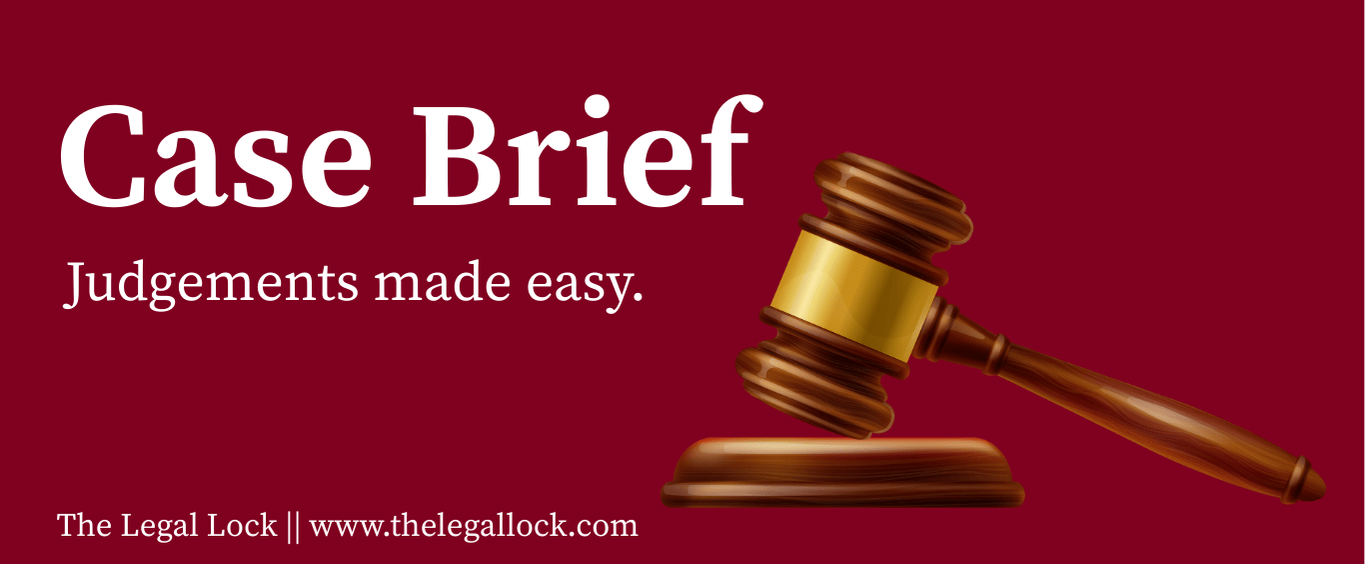Case Brief: S.P. Gupta v. Union of India

| CASE NAME | S.P. Gupta v. Union of India, 1981 Supp SCC 87 |
| CASE NAME (Also known as) | First Judges case |
| CITATION | 1981 Supp SCC 87 |
| COURT | In the Supreme Court of India |
| BENCH | Before P.N.Bhagwati, A. C. Gupta, S.Murtaza fazal ali, v.d. Tulzapurkar, D.A.Desai, R.S.Pathak, and E.S. Venkataramiah, JJ. |
| APPELLANTS | S.P. GUPTA |
| RESPONDENTS | UNION OF INDIA AND ANOTHER |
| DECIDED ON | Transferred Cases Nos. 19, 20, 21, 22, 2, 6 and 24 of 1981 and W.P. No. 274 of 1981, decided on December 30, 1981 |
Introduction:
An essential component of the Indian government and the basis of the country’s democratic system is the judiciary. It has continuously complied with the public’s requests for justice over time. The highest court in India, the Hon’ble Supreme Court, has protected fundamental rights in addition to interpreting the Indian Constitution. As a defender of the Constitution, the court has tackled a wide range of topics with its varied verdicts and recommendations. Notable examples include elucidating protocols for recommending candidates to the Supreme Court and High Court, as well as offering advice on how to stop sexual harassment of women in the workplace.
The number of judges in the Supreme Court is decided by the Parliament in accordance with Article 124 of the Indian Constitution. With the exception of the Chief Justice of India, there are 33 judges at this time. Judges of the Supreme Court are all nominated by the President and hold office until they are 65. Article 217 outlines the criteria for appointing High Court judges, with the President making appointments based on recommendations from a collegium formed for this purpose. The article specifies disqualifications for judges, including non-Indian citizenship, insufficient judicial experience (less than 10 years), or less than 10 years of advocacy practice in the High Court.
S.P. Gupta, throughout his extensive career, held significant roles such as Advocate General for the State of Uttar Pradesh on three occasions and served as a pleader in the Allahabad High Court since 1951. His noteworthy involvement in a case left a lasting impact on the evolution of the nation’s collegium system for appointing judges.
Brief fact:
A common topic was the subject of several writ petitions filed in 1981 by a number of lawyers and practitioners in a number of high courts. A government decree on the transfer and non-appointment of two judges was challenged in each petition. The first and second petitions were specifically lodged in the Bombay High Court and Delhi High Court, respectively. Both petitions raised constitutional concerns regarding the process employed for designating judges to higher courts, challenging the Central Government’s order.
Article 224 of the Constitution was allegedly violated by the three new judges’ short-term appointments to the Supreme Court, which were highlighted in the petitions. The petitions aimed to create judicial independence by requesting the appointment of extra judges to permanent positions.
At that time, Justice Murlidhar, Justice A.N. Verma, and Justice N.N. Mittal’s appointments as extra judges in the High Court were the subject of several petitions that S.P. Gupta, an advocate of the Allahabad High Court, filed before the Supreme Court. An advocate from the Ministry of Law and Justice disputed the validity of these petitions, arguing that the judges’ term-limited appointments and the government’s decision had not caused any legal injury to anyone.
Issues:
- The judiciary’s independence and the process for appointing judges to higher courts constituted another crucial concern.
- The primary question in this case concerned whether the Central Government’s directive prohibiting the appointment of new judges and the temporary replacement of existing justices in High Courts was constitutional.
- There was also controversy around the letter that disclosed communications between the Chief Justice of India, the Chief Justice of the Delhi High Court, and the Minister of Law.
- Additionally contested was the petitioners’ locus standi.
Arguments of both parties
Arguments of the petitioner:
In their comments, the petitioners contested the constitutionality of the Central Government’s directive, claiming that it implicitly threatened to undermine judges’ professional permanent status if they did not agree to be appointed as additional judges. They also demanded the release of all correspondence and communications pertaining to judges’ temporary transfers and lack of appointments.
Another argument put forth was that the President failed in fulfilling the duty outlined in Article 216 of the Constitution to appoint judges in the court effectively addressing the backlog of pending cases. As a remedy, the petitioners sought a writ of mandamus against the President. Moreover, they claimed that the procedure stipulated under Article 124 had not been adhered to properly.
Arguments of the respondents:
The respondents used Article 74(2) to argue that any advice the President receives from ministers in the Council of Ministers is exempt from legal challenge or interrogation in response to the request for disclosure. The Indian Evidence Act, 1872, Section 123, which forbids the use of unpublished papers as evidence in court, was also mentioned by them. In relation to the publication of documents, the respondents referred to the precedent set in the case of State of Punjab v. Sodhi Sukhdev Singh (1961). The Court in that case held that when a document falls within the realm of ‘state affairs,’ the head of the department has the authority to decide whether it should be published. The Court further underlined that Section 123 of the Evidence Act shields advice provided by the Council of Ministers during sessions from disclosure.
In response to another point, the respondents stated that as the petitioner has not experienced any harm, their case should not be maintained. According to their perspective, if the petition were to be filed, it should have been done by the judges appointed as additional judges. Therefore, the respondents contended that the court should not entertain the petitions since the petitioners are not the ones who have experienced any injury or loss due to the Central Government’s order.
Judgement:
In this instance, Judge S.N. Kumar’s decision to not extend the term of another judge was confirmed by the majority judgement, which had a 5:2 ratio. Justice Bhagwati suggested creating a collegium to suggest applicants to the President for appointment as judges of the Supreme Court and High Courts. Judges Pathak and Tulzapukar, on the other hand, stressed the need of giving the Chief Justice of India’s opinion and advice the highest regard. There was broad agreement that “consultation” meant careful and efficient consideration of all pertinent information by constitutional officials prior to decision-making.
The court decided that none of the opinions of constitutional officials are admissible when they dispute about who should be chosen to serve as a judge in a High Court. While consultation with the Chief Justice of India is mandatory before selecting a Supreme Court justice, the Central Government is not required to heed the Chief Justice’s advice. Instead, the government has the authority to make its own decisions regarding which opinion to accept when appointing a judge. This aligns with the constitutional norm observed in democratic countries, wherein the central government has the final say over appointments.
According to Justice Venkataramaiah, Article 217 of the Constitution grants the President of India the power to designate judges for the High Courts. The President is obligated to consult with designated authorities, but need not follow their recommendations to the letter. In instances of conflicting opinions, the President is mandated to consider each piece of advice received, deliberate independently, and then arrive at a decision. It is crucial to note that the President is not bound by the advice but is rather guided by it to ensure a judicious and impartial decision-making process.
Justice Bhagwati stressed that the Chief Justice of India as well as the Chief Justice of the Delhi High Court are both consulted in this regard. Crucially, advice from the Chief Justice of India or from any other source should not unduly influence or take precedence over that of the latter. The President, during the consultation process, is obliged to accord equal significance to all advice received, without showing favoritism or giving undue precedence to one over the other. This underscores the principle that all inputs are to be considered on an equitable basis to uphold fairness in the decision-making regarding the appointment of High Court judges.
The petitioners contended that because the word “may” appears in Clause 2 of Article 124, the Central Government is free to consult judges in the process of choosing judges, and in the event that it does not, the Chief Justice of India’s judgement ought to be followed. The court explained that the word “may” in the clause gives the Central Government discretion over which judges to contact, but it does not grant them the choice of consulting or not. As a result, the Central Government has the last say over appointment decisions, even though consultation is necessary. The ruling maintained the supremacy of the Executive in the appointment and removal of judges, but it also endorsed the notion of selecting and reassigning justices via a collegium.
Analysis and Conclusion:
This historic case is very important because it is the first time that the Court has dealt with concerns related to the appointment of judges to both the Supreme Court and the High Courts. The case covered a number of topics, such as the independence of the judiciary, how the word “consultation” should be interpreted, the President’s power to name justices to the Supreme and High Courts, and the creation of the collegium system. It also expanded the use of Public Interest Litigation (PIL) by allowing those who are not directly impacted to file a PIL on their own behalf. The case emphasised the significance of Article 19(1)(a) of the Constitution’s guarantee of the right to information as a necessary component of the freedom of speech and expression. The legal system has advanced subsequently as a result of its outcomes. There is still quite a distance to go. Because of its insufficient standards and lack of openness, the current collegium system for appointing judges is still vulnerable to nepotism. In the near future, these difficulties might lead to more legislative declarations intended to allay worries and accomplish the ultimate goal of total judicial independence.






